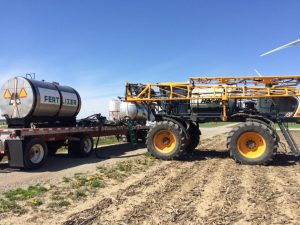Agronomy, Conservation, Homepage Slider
Agricultural Microbiological Products
By James Hoorman, Hoorman Soil Health Services
This of the time of year when farmers are considering options for buying seed, fertilizer, various pesticides (herbicides, fungicides, insecticides) and other products for next year’s crop. Now farmers may want to consider buying agricultural microbiology products which require even more specialized knowledge. This article will attempt to give some basic information about agricultural microbiological products and what they do.

Microbial products have many names including crop probiotics, bio-fertilizers, bio-stimulants, bio-controls, or bio-fungicides. They can be applied to the soil, seed, or as inoculants; with or without carriers like compost, peat, or stickers. Buying microbiological products is like moving to the wild west. While almost all products generally will or can work, they are fickle and may not work every year due to various environmental conditions. Handling, storage, and applying the microbes at the right time, place, and rate to soil, seeds, and plants can be challenging (Penn State).
Crop probiotics are live microbes applied to the soi, seed or plants to improve plant health. These microbes are usually bacteria, fungi, actinomycetes, protozoa, yeasts, or virus. Bio-fertilizers have the ability to improve plant growth and provide resistance to many pests. Bio-fertilizers are mostly associated with bacteria or arbuscular mycorrhizal fungi (AMF). AMF have about 250 agricultural species which colonize the roots. AMF make nutrients plant available including phosphorus, many micro-nutrients, and water. The plant supplies the AMF with sugar, so the AMF has a vested interest in protecting the plant from insects and disease. AMF fungi are somewhat specific to each plant species and are greatly affected by local environmental conditions and competition from other microbes. Valent’s EndoPrime © is a type of bio-fertilizer that is a combination of 4 AMF fungi species known to improve corn and soybean yields which works about 80% of the time but has a money back guarantee.
There are several types of bio-stimulants or biologically derived fertilizer additives. They are used in agriculture to supplement or enhance existing products like fertilizer, helping to improve nutrient-use efficiency. Some examples might include humic and fulvic acids, seaweed, natural plant extracts, amino acids and proteins. Most occur naturally in soils as a result of the breakdown of organic matter. Bio-stimulants enhance nutrient uptake, improve crop quality, improve yield, and help plants tolerate stress.
Biological control (bio-control) products reduce pests by increasing natural enemies such as parasitoids, predators, pathogens or competitors to suppress a pest. Biological control is generally a practical way to suppress pests while being easy and safe to use. A common example is Bt or Bacillus Thuringiensis which is a gram-positive bacteria used as a natural insecticide to kill flies, gnats, caterpillars, mosquitos and certain beetles.
Bio-fungicides are also living organisms that are used to control pathogenic fungi and bacteria. Bio-fungicides directly compete with pathogens by growing a dense barrier around a root system to shield the plant root from a pest attack. They produce a chemical similar to antibodies which are toxic to the invading pathogen.
There are many factors limiting microbiological product usage. First, while fertilizers and pesticides are heavily regulated, microbiological products are not so there is limited regulation and safety. For these products, there are no guarantees, so buyer beware! Second, the microbes or microbial by-products have to survive in a foreign environment. Since microbes are living organisms, weather impacts survivability. Excessive dry or wet soils reduce microbial populations as do soil temperatures above 800 F. Live organisms also need a food source so live roots and plants in the winter can help improve soil conditions for hungry transplanted microbes.
Third, soil disturbance affects microbial populations. Different communities of microbes exist in no-till versus tilled systems. Tillage generally hurts sensitive beneficial microbes which require a more stable environment and habitat to survive. Fourth, there are many predators which vastly outnumber the small amounts of applied beneficial microbes or products. Fifth, soil microbes face a lot of competition. A typical soil measuring one square yard and 6 inches deep may have 100 trillion competitors. A ten-gallon bacteria product may have 2.5 billion bacteria applied per acre which amounts to .0025%. In a highly competitive environment, these new colonizing microbes or products can have a tough time surviving!
While using microbiological products might seem crazy, it appears to be the wave of the future. Planting cover crops, using no-till, improving drainage, and adding moderate amounts of manure or compost can greatly increase agricultural microbiological product efficacy.